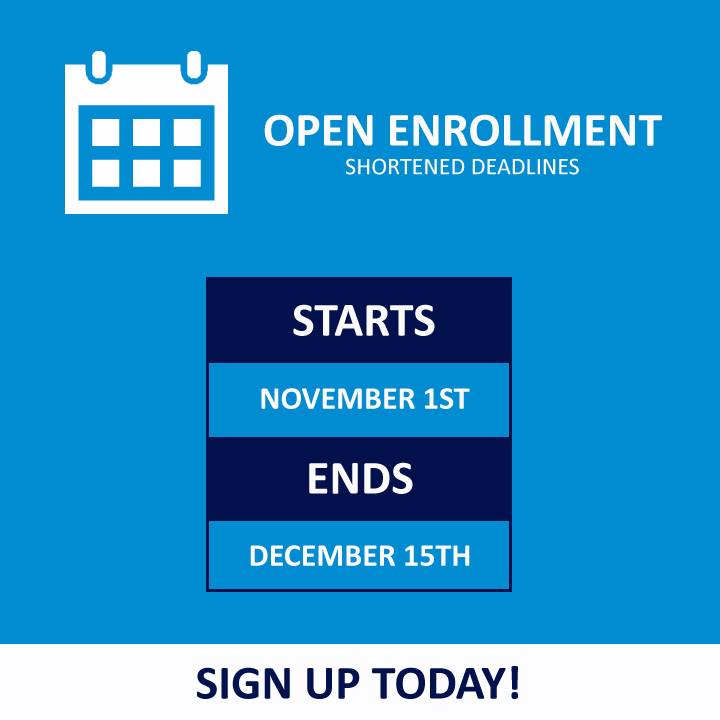It’s that time of year again!
It’s time to start thinking about your health insurance during the open enrollment period. If you want to buy individual or family health insurance for 2018 now is the time to do it. Today we’re sharing the 10 basic items to think about while you navigate the open enrollment period.
- The open enrollment period this year has been cut in half. The new dates for open enrollment are Nov.1, 2017 to Dec. 15, 2017. With coverage starting Jan. 1st, 2018.
- You need to sign up through open enrollment if you do not have health insurance from a different source such as –
- Employer or Spouse employer
- Government coverage (such as veterans, Medicare or Medicaid)
- Over the age of 26 and no longer on your parents
- You qualify for tax credits
- This is the time to make changes to your current plan
- You can renew your current individual/ family health insurance plan
- You can choose a new health insurance plan through the market place
- Make sure your Doctor and Hospital are still in your network
- Check your drug plan, make sure pricing stayed the same
- If you miss open enrollment you may have to wait for a year to sign up, unless you have qualify for a special enrollment period, which includes:
- Divorce
- Marriage
- Birth or adoption of a child
- Death of a spouse or partner that leaves you with not health insurance
- Lose your job
- If you choose to ignore signing up for health insurance, the penalties/fees are as follows:
- 5% of your income or $695 per adult (whichever is more)
- Up to $347.50 per child
- With the maximum being $2,085
- Once you are ready to choose a plan, you have four choice levels:
- Bronze- lowest premium/ highest out of pocket
- Silver
- Gold
- Platinum – Highest premium/ lowest out of pocket
- All health plans must cover these 10 items:
- Outpatient care including chronic disease management
- Emergency care
- Hospitalization
- Pregenancy and newborn care
- Mental health and substance abuse services
- Prescription drugs
- Rehabilitation services and devices
- Lab tests
- Preventive and wellness services
- Dental and vision care for children
- Your family size and income determines your eligibility for tax credit. You can use this grid to find out whether you will be eligible for tax credits or not:
| 2017 federal poverty level guidelines (applies to 2018 coverage) | ||
| Persons in Household | 2017 federal poverty level for continental U.S. | Premium subsidy threshold (400% of federal poverty level) |
| 1 | $12,060 | $48,240 |
| 2 | $16,240 | $64,960 |
| 3 | $20,420 | $81,680 |
| 4 | $24,600 | $98,400 |
| 5 | $28,780 | $115,120 |
| 6 | $32,960 | $131,840 |
| 7 | $37,140 | $148.560 |
| 8 | $41,320 | $165,280 |
- If you suffered a hardship, you may not be required to buy health insurance
- Being uninsured for less than three months of the year
- A close family member rently died or you had unexpected expenses related to caring for an elderly, ill or disabled family member
- You have been evicted from your home or suffered bankruptcy
- The five ways to sign up
- Phone
- Online
- In person with a certified attendant
- Agent/ broker
Contact us today and and one of our Agents will help you sign up for health insurance! The best part? NO FEES! Make sure you choose the best plan for you and your family by setting up an appointment today with us.
No Fields Found.
